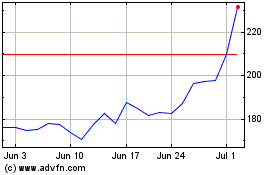Down 55% From All-Time Highs, Is Ford Stock a Good Buy Right Now?
May 29 2023 - 7:23AM
Finscreener.org
In the turbulent stock market
seas, sell-offs can be intimidating. Yet, they often present
opportunities to buy quality companies that have demonstrated their
capacity to weather even the fiercest storms. Consider, for
instance, the storied automaker Ford Motor
Company (NYSE:
F), whose stock is
currently down 55% from its all-time high.
In January 2022, FordU+02019s
market capitalization exceeded $100 billion for the first time in
its history. Investors were buoyed by the companyU+02019s renewed
focus on electric vehicles (EVs), which CEO Jim Farley placed at
the heart of his turnaround strategy. But as we forge into 2023,
FordU+02019s stock has seen a steep decline from that
peak.
Ford aims to improve profit margins
The company flagged unexpectedly
high costs throughout 2022 due to inflation and supply chain
disruptions, culminating in a net loss of $2 billion for the year.
However, Farley was forthright during the companyU+02019s Q4
earnings release: "We should have done much better last year," he
conceded. Ford also acknowledged letting "$2 billion in profits
slip through its fingers" due to controllable factors.
Regardless, Ford isnU+02019t
turning down the volume on its ambitions. Instead, the automaker is
sticking to its 2023 guidance, projecting between $9 billion and
$11 billion in adjusted EBIT and approximately $6 billion in
adjusted free cash flow.
FordU+02019s goal is to achieve
an 8% EBIT margin on its EV unit and reach a production rate of two
million EVs by 2026, a significant increase from the projected
600,000 by the end of this year.
This plan has faced criticism for
its aggressive nature.
Still, Ford seems undeterred,
sticking to its vision while laying out a detailed roadmap of
profit expectations for its critical business units. CFO John
Lawler was frank in acknowledging past shortfalls: "WeU+02019ve
talked about this for years. YouU+02019re not going to believe us
until we start
delivering it… we have to prove
it." The companyU+02019s new commitments will thus be crucial in
proving to Wall Street that its ambitious goals are more than just
lofty promises.
FordU+02019s "Model E" EV
business is projected to incur a $3 billion loss this year, but
profits from its traditional "Blue" and "Pro" fleet businesses
should provide a buffer. Meanwhile, the companyU+02019s traditional
car business reported earnings of $2.6 billion in Q1, and its fleet
operations pulled in $1.4 billion.
Moving forward, Ford aims to
streamline operations and boost profits from traditional products
to low double-digit EBIT margins, a substantial improvement from
7.2% in 2022. The company
also plans to increase the capacity for its internal combustion
vehicles by over 160,000 units in the next ten months.
As part of its forward-looking
strategy, Ford also aims to leverage software and subscription
revenue models. For example, the companyU+02019s BlueCruise
hands-free highway driving system could generate $200 million in
revenue, based on an expected take rate of 20% from an estimated
half a million vehicles equipped with the technology in
2024.
Ford and Tesla forge an EV partnership
Adding another string to its bow,
Ford recently announced new supply deals for lithium products to
support its ambitious plans to boost electric vehicle production in
the coming years.
These collaborations include a
"strategic partnership" with Albemarle
(NYSE:
ALBE) to supply more than
100,000 metric tons of lithium hydroxide – enough for approximately
3 million EV batteries – from 2026 to 2030.
They will also collaborate to
develop battery-recycling solutions, a critical element of
sustainable EV production. Other agreements with
Compass Minerals International (NYSE:
CMP), EnergySource
Minerals, and Canadian miner Nemaska Lithium will further ensure
FordU+02019s access to vital lithium resources.
In another surprising turn of
events, Ford announced a partnership with its competitor
Tesla (NASDAQ: TSLA)
on charging initiatives for its current and future electric
vehicles. This partnership, confirmed by Ford CEO Jim Farley and
Tesla CEO Elon Musk, will allow current Ford owners to access more
than 12,000 Tesla Superchargers across the U.S. and Canada starting
next year, using an adapter.
Furthermore, FordU+02019s
upcoming generation of EVs – expected by mid-decade –will feature
TeslaU+02019s charging plug. This integration will allow Ford
vehicle owners to charge at Tesla Superchargers without an adapter,
marking Ford as one of the first automakers to directly tap into
TeslaU+02019s extensive charging network.
Though Tesla continues to
dominate the EV sector by a significant margin, Ford ranked second
in fully electric vehicle sales in the U.S. last year, with 61,575
electric vehicles sold. This collaboration with Tesla signifies
FordU+02019s commitment to the EV sector and its readiness to adapt
and innovate to compete more effectively.
So, is Ford stock a good buy?
Given the companyU+02019s
significant investments in EVs, its improving profits, its
strategic partnerships for crucial minerals, and its willingness to
work with competitors to achieve greater access to essential
infrastructure, the future for Ford appears promising.
Investing in a company during a
downturn may feel counterintuitive, but FordU+02019s ongoing
initiatives indicate that it is a company preparing for growth. Its
strong focus on EVs, backed by important supply deals and strategic
partnerships, suggests a company that is not merely
riding
Tesla (NASDAQ:TSLA)
Historical Stock Chart
From Mar 2024 to Apr 2024

Tesla (NASDAQ:TSLA)
Historical Stock Chart
From Apr 2023 to Apr 2024
